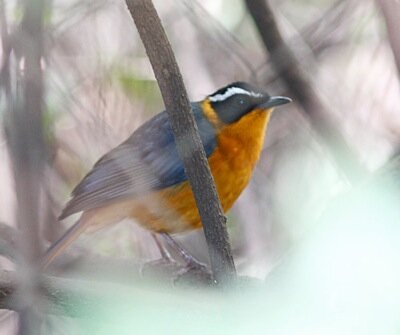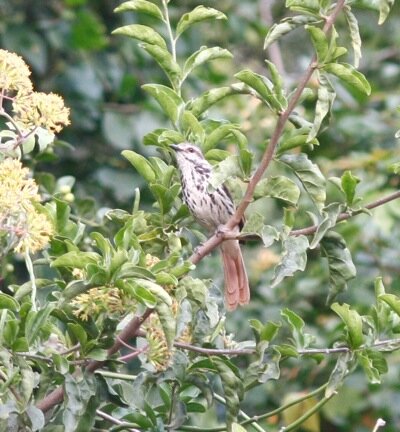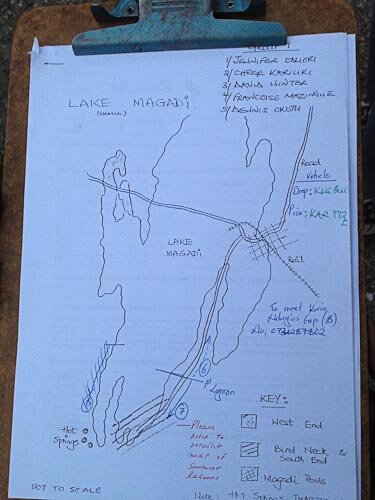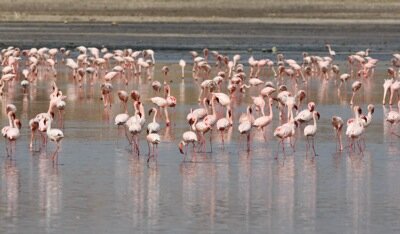|
|
March 16th, 2015
I thought my day of birding in Nairobi National Park would be hard to top, but a day trip to Eburru Forest with the Onsight Expedition Team was a fantastic experience and it offered a whole suite of new birds for me. Onsight Expedition run regular monthly (sometimes bi-monthly) day trips to locations within a few hours of Nairobi. The focus of the well-priced trips are usually hiking, but this is dependent on the group as the guides are all experienced birders so they’re happy to focus on birding for those interested.

Lake Naivasha. Google Maps image.
Eburru Forest is about a 2.5 hour drive to the north-west of Nairobi; the mountain flanks Lake Naivasha National Park.

Eburru Forest. Google Maps image.
Eburru Forest is better known as a site where you can find Mountain Bongo (Tragelaphus eurycerus ssp. isaaci) a critically endangered sub-species of antelope. Here is some more information from the IUCN Red List:
Historically, the Mountain Bongo occurred in and around forested zones of Mt. Kenya, the Aberdares, Mau forest, Cherengani hills and Chepalungu hills in Kenya and Mount Elgon in Kenya and Uganda (Elkan and Smith in press). The Mountain Bongo was exterminated from the Uganda side of Mount Elgon around 1913-1914 (Kingdon 1982). It is now confined to four completely isolated populations in patches of forest on Mt. Kenya, the Mau and Eburu forests, and the Aberdares in Kenya (Elkan and Smith in press). The current population estimate (2007) for the Mountain Bongo is ca. 75-140 individuals: Aberdare Mts (50-100); Mt Kenya (6-12); Mau Forest (6-12), Eburu Forest (6-12) (M. Prettejohn and L. Estes in litt to ASG 2007). [more here]
We unfortunately didn’t bump into a Mountain Bongo, but as they’re nocturnal and only an estimated 6-12 individuals at Eburru Forest, I wasn’t holding out much hope. We did however have an armed soldier walk with us as buffalo are known to occur in the forest on occasion. Thankfully, another species we didn’t encounter.

Eburru Forest Walkers
Our group for the day mostly comprised of walkers, but that suited me fine because our route was a return walk along the main forest trail so this allowed me to dawdle along behind the group to bird and take pictures. My net result of new birds was likely less than if I’d remained with one of the guides, but I enjoyed the solitude of finding different bird parties and trying to work out what I was seeing and hearing (sans field guide again!).

Eburru Forest Trail
When I was trying to decide whether I should join the day trip I “Google Imaged” the search terms “Eburru Forest birds” and was super excited when images of Golden-winged Sunbird appeared. I was sold. The trail we walked started in scrubby, secondary growth and slowly developed into more mature forest as we progressed. The secondary growth was dominated by Leonotis nepetifolia, a favourite food source of Golden-winged Sunbird.

Golden-winged Sunbird
I was a very easy customer to please that day as essentially the first bird we recorded when alighting from the vans was Golden-winged Sunbird. The Leonotis bushes were practically dripping with males and females feeding and chasing each other, as only sunbirds can. I’m afraid Bronze Sunbird, which were also in attendance and are also an attractive species, were relegated to the category of “shabby cousin” as the Golden-wingeds were just superb!

Golden-winged Sunbird

Golden-winged Sunbird – sans central tail feathers

Golden-winged Sunbird – immature
My photos certainly don’t do them justice, but you’ll have to believe me when I say they are by far the best looking sunbird I’ve ever seen.

Bronze Sunbird
I had to tear myself away from the sunbirds as I knew I’d be missing out on other species if I didn’t. Forest birding can be an acquired taste as there are often periods of very little bird activity followed by a flurry of different species at once, if you’re lucky. Birding by ear is another important tool if you want to stand a reasonable chance of seeing anything, but if you don’t know what you’re listening to it can be tricky.

Doherty’s Bush-shrike
I was lucky with this Doherty’s Bush-shrike as it first called from some dense scrub and was thankfully incredibly responsive to “spishing” as I had no idea what it was until it stuck it’s gorgeous head above cover.

European Blackcap – male
This male European Blackcap had me going for a while. I initially thought it was a Garden Warbler as it warbled away very quietly in a dense tangle, but it finally revealed its true identity when it popped out onto a branch. I’m used to hearing the rather loud song of Blackcap in its summer territory rather than this very subtle version. Perhaps a good rule of thumb when separating the two species on song is, if you think you’ve got a Blackcap it should eventually reveal itself (as they’re far more “showy” than Garden Warbler), but if you think you’ve got a Blackcap and it doesn’t budge then perhaps you’ve got a Garden Warbler? Mmmh, or perhaps just study the calls a bit more carefully 

Black-billed Weaver
I recorded two pairs of Black-billed Weaver, a species that the Onsight bird guides were quite surprised about. Apparently it’s not a species they’ve seen in the area before. They also responded very well to spishing.

Black-collared Apalis
I enjoyed tracking down and finally photographing and recording this Black-collared Apalis. I’m used to the more typical calls one hears from southern African apalis species so I was quite surprised when I finally managed to connect the bird with the call I was hearing.

Grey Apalis
Here’s another apalis call, this time Grey Apalis, a call type much closer to that of Bar-throated Apalis, a common species from my home patch in Cape Town. I thought I was picking up most of the birds around me, but the value of home ground advantage was highlighted when one of the Onsight Expedition guides easily pointed out a few new species just based on call, like this Brown Woodland Warbler.

Brown Woodland Warbler
Below are the balance of my photos from the day:
-

- Mountain Greenbul
-

- White-eyed Slaty Flycatcher
-

- Streaky Seedeater
-

- Starred Robin
-

- Olive Thrush
-

- Montane White-eye
-

- Long-crested Eagle
-

- Lesser Honeyguide
-

- Hunter’s Cisticola
-

- Hartlaub’s Turaco
David Winter
March 10th, 2015
Long business trips can be taxing, but when they include exotic birding locations like Kenya I look at them in a whole new light. A recent trip to Nairobi involved a weekend so I made sure that I put the time to good use and organized a birding trip on both the Saturday and Sunday. Despite this being my 5th trip to the capital, I’d never managed to visit Nairobi National Park so I really had to remedy that.

Nairobi National Park. Google Earth image.
One thing you notice when flying over Nairobi is that apart from the city’s sprawling urban areas you spend a lot of time flying over expanses of golden grassland, large portions of which can be attributed to the Nairobi National Park. Boasting a bird list of well over 500 species (Brian Finch identified the park’s 529th species in 2010 – an African Stonechat), and given it’s proximity to Nairobi, I would say the park is well worth a visit for birders new to East Africa.

Red-cheeked Cordon-bleu
I looked at various travel options to get to the park, but in the end decided that hiring a taxi with a driver was the best value for money and it also allowed me go at my own pace as I generally try and photograph any birds I see, particularly new ones. Also, a real rookie error, I managed to leave my Birds of East Africa field guide back in South Africa so I needed as much photographic evidence as possible to identify some of the birds. In terms of costs, the taxi driver charged me KES 6500 ($70) for a full day of driving (7am-6pm) and the park entrance for both of us was about KES 5500 ($60), which I thought was pretty steep, but understand that most East African parks are expensive. My driver, Kiteme, was great and by the end of the day he was pretty sharp at picking up distant birds. Importantly, he was also very patient with me and had no problem maneuvering the car to help me photograph birds. What follows is a selection of photos from the day with a bit of commentary.

Grey-capped Warbler
One of the first birds of the day was Grey-capped Warbler. I’ve seen this species before in Uganda, but never one quite as confiding as this individual. It was calling from some shrubbery bordering the parking lot of the main entrance to the park. Some gentle spishing and it just popped into view.

Spot-flanked Barbet
Our first stop for the morning was the Ivory Burning site where you can get out of your car and walk around. I was quite chuffed with myself when I recognized a calling barbet and managed to track down this Spot-flanked Barbet in a nearby tree.

Tree Pipit
A Tree Pipit kept me distracted for a good 10 minutes as it played hide and seek, but I finally managed to snap this shot.

Red-rumped Swallow
The last time I saw Red-rumped Swallow was April 1999 in southern Spain and this was my first sighting in Africa, so I was quite excited when a small group of them perched and started calling at the Ivory Burning site. What I remember when first seeing Red-rumped Swallow in Spain was how similar they are to Greater-striped Swallow, not only in appearance, but they also have similar calls. Take a listen, I managed to record this short clip with my iPhone – sorry about the plane noise in the background, there’s an airport nearby and Saturday mornings seem to be a popular practice time.

White-bellied Bustard
I didn’t spot the first of three White-bellied Bustards we saw – I was busy watching a Rufous Sparrow when my driver, Kiteme, skillfully maneuvered the car to give me great views of this individual. White-bellied Bustards can be pretty shy birds in South Africa so I really enjoyed the experience.

Male Rufous Sparrow

Female Rufous Sparrow
Rufous Sparrow, what a smart bird, the male at least. It really reminded me of Cape Sparrow, a smart endemic from Southern Africa.

Pied Wheatear
I really enjoyed the wheatears and chats in the park, particularly as they are vagrant visitors to Southern Africa and are yet to grace my list for the sub-region. Pied Wheatear was pretty common and the easiest to identify.

Pied Wheatear – ‘vittata’ race
This Pied Wheatear appears to be of the ‘vittata’ race, an uncommon sighting according to the Birds of East Africa.

Isabelline Wheatear
With no prior experience I found separating this Isabelline Wheatear from Northern Wheatear a tad tricky, but Brian Finch helped by confirming its identity.

Whinchat
Whinchat is another Southern African vagrant that I’ve yet to see in the region so I was tempted to sneak one into my luggage 

Rufous-naped Lark
This Rufous-naped Lark was particularly confiding, but what was most interesting about it was the call it was making. I’m used to the typical three-syllabled call of the southern African race, but take a listen to this short clip I managed to record with my iPhone.

Long-tailed Shrikes were common in the park
Below is the balance of my photos from the day. If anyone is looking for a taxi driver that is prepared to take them to Nairobi National Park let me know and I’ll put you in touch with Kiteme.
David Winter
-

- Grassland Pipit
-

- African Silverbill
-

- White-bellied Tit
-

- Cinnamon-breasted Bunting
-

- Isabelline Shrike
-

- Stout Cisticola
-

- Temminck’s Courser
-

- Black-winged Lapwing
-

- Yellow Wagtail
-

- Marabou Stork
-

- Stout Cisticola
-

- Long-tailed Shrike
-

- Grassland Pipit
-

- Striped Kingfisher
-

- Ostrich
-

- Grassland Pipit
-

- White Rhino
-

- Grassland Pipit
-

- Diederik Cuckoo
-

- Lesser Kestrel
-

- Stout Cisticola
March 3rd, 2015
I managed to leave my field guide at home when visiting Kenya last month (rookie error when traveling in a new country!) so I wasn’t able to pin down some of the IDs in the field. I took these photos in Nairobi National Park. Any thoughts on each bird’s identification would be much appreciated – feel free to add comments below.

Wheatear 1
My feeling is that this is an Isabelline Wheatear given the black alula and the extent of white in front of the eye, but I have no experience separating Isabelline from Northern Wheatear.

Pipit 1

Pipit 2

Pipit 3
I saw a lot of pipits in Nairobi National Park and most resembled African Pipit, but I have seen literature mentioning “Nairobi Pipit” and the likes so I thought I’d seek opinion on these. Pipits 1 and 2 remind me of African / Grassveld and Pipit 3, given its longer-legged appearance and bulkier giss I’d lean towards Plain-backed. Any thoughts on these pipits?

Cisticola 1

Cisticola 2

Cisticola 3
Sorry, but I had to include some Cisticolas and some rather rubbish images to boot. I realise habitat and call provides a bit more context, but does anyone have any thoughts?
Thanks in advance,
David Winter
April 9th, 2013
A business trip to East Africa last year had me thinking about what birding opportunities I could capitalise on over the two weekends I was in the region. My first stop in Dar es Salaam was rather birdless, apart from a Dimorphic Egret sighting in the traffic one morning and literally 1000s of House Crows. The number of crows in Dar, and the lack of any other passerines, highlighted the importance to me of eradicating the few House Crows we have in Cape Town.

Lake Magadi Map [adapted from Google Earth]
The birding in Nairobi was far more fruitful. I stayed at the leafy Fairview Hotel, which allowed me to catch-up with some common Nairobi garden birds. Baglafecht’s Weaver, Montane White-eye and Ruppell’s Robin-chat were common visitors to the verdant garden setting of the Fairview.

Montane White-eye

Baglafecht’s Weaver

Ruppell’s Robin-chat
As I was going to spend a weekend in Kenya I decided to contact the local birding-pal network to see if a Kenyan birder could give me some local gen. As luck would have it I contacted John Musina from the Department of Ornithology at the National Museum of Kenya and he responded almost immediately saying that I was welcome to join him and his team for the Lake Magadi birding count that weekend. What a luck! Not only was I welcome to join them, but all I had to do was get myself to the National Museum on Saturday and all other logistics would be arranged by the museum. It sounded too good to be true, but by midday on Saturday I was pottering around the National Museum’s garden notching up a few species for my trip list while I waited for our departure. The museum gardens are not a bad place to go birding, and I believe they run bird walks around the leafy grounds every Wednesday morning. In my short wait I managed to notch up Speckled Mousebird (rather a different beast to our southern variety), Cinnamon-chested Bee-eater and Streaky Seed-eater.

Speckled Mousebird

Streaky Seed-eater
Kenya is making a concerted effort to sort out its road infrastructure, and this is very evident when traveling around Nairobi as each major intersection seems to be sporting a construction team of sorts. However, call me a cynic, but give Kenyan drivers the best roads in the world and there will still be 5 hours of rush hour traffic every evening – they just do not abide by any rules of the road!! I digress. As soon as everyone had finally arrived at the museum we were on our way. Lake Magadi is to the south west of Nairobi and about a 3 hour drive on possibly the worst “tar” road Kenya has to offer. We did stop a couple of times en route to stretch the legs and see what birds were around. It was great to get out the car and walk a bit – birding highlights were Sooty Boubou, Blue-capped Cordonbleu, Red-fronted Barbet, White-bellied Go-away-bird, Schalow’s Wheatear, Spotted Morning-thrush, Black-backed Puffback, Eastern Chanting Goshawk and Hildebrandt’s Starling.

Birding the road en route to Lake Magadi

Spotted Morning-thrush

Red-billed Firefinch

White-browed Scrub-robin
By the time we arrived at Lake Magadi it was getting dark so tents were quickly pitched before heading over to the local town hall for dinner and a lecture on the birds of Lake Magadi. Lake Magadi is the southern-most lake in Kenya’s Rift Valley lying just north of Lake Natron in Tanzania, and home to large populations of wading birds, particularly Lesser Flamingo.

My bird count team
I was really impressed with the way this bird count was organised and also how keen Kenyan birders are! This count takes place twice a year and on this occasion there were at least 50 people in attendance. The map below depicts the careful planning that John Musina carries out prior to all the count teams being sent on their way. I was also totally amazed by the hospitality and generosity extended by John to me on this bird count weekend. Not only did he arrange my transport and food, but he also lent me a sleeping bag and made sure I had a tent to sleep in – superb Kenyan hospitality!

Meticulous bird count planning
On Sunday morning after a quick breakfast we headed off to count our section of the lake. You can ask any hardcore bird counter, but counting birds is not birding. When you’re counting birds you’re counting birds, kapish? There’s generally no time to ogle over anything of interest. I, however, was lucky. My group included a few inexperienced birders so the pace was a bit slower than usual and our leaders were, thankfully, not hardcore counters so some birding was allowed 

Lake Magadi birding..ahem, I mean counting

One, two, three, four…

Another bird count team
In between counting Lesser Flamingos, of which there were decent numbers (1000s), I managed to notch up a few lifers. Top new birds included Fischer’s Sparrowlark, Chestnut-bellied Sandgrouse and Greycapped Sociable-weaver.

Lesser Flamingos

Fischer’s Sparrowlark

Chestnut-bellied Sandgrouse

Greycapped Sociable-weaver
Counting birds is not for sissies. We walked for at least 4 hours in blazing Rift Valley sun, but jeepers it was worth it. Not just the birds were amazing, but the passion of the Kenyan birders that accompanied me was really unforgettable. Next time I’m in Nairobi I’ll definitely be contacting John to find out if I can join his next count expedition!

Other species notched up in and around the pans included: Greater Flamingo, Chestnut-banded Plover, Speckled Pigeon, Yellow-bellied Eremomela, Eastern Violet-backed Sunbird, Cape Teal, Yellow-rumped Seed-eater, Somali Golden-breasted Bunting, Cut-throat Finch, African Mourning Dove, Red-billed Firefinch, Red-billed Quelea, Yellow-spotted Petronia, Chestnut Sparrow, Yellow-billed Oxpecker, Slate-coloured Boubou and Blue-naped Mousebird.
David Winter
|
|
![]()























































































Recent Comments